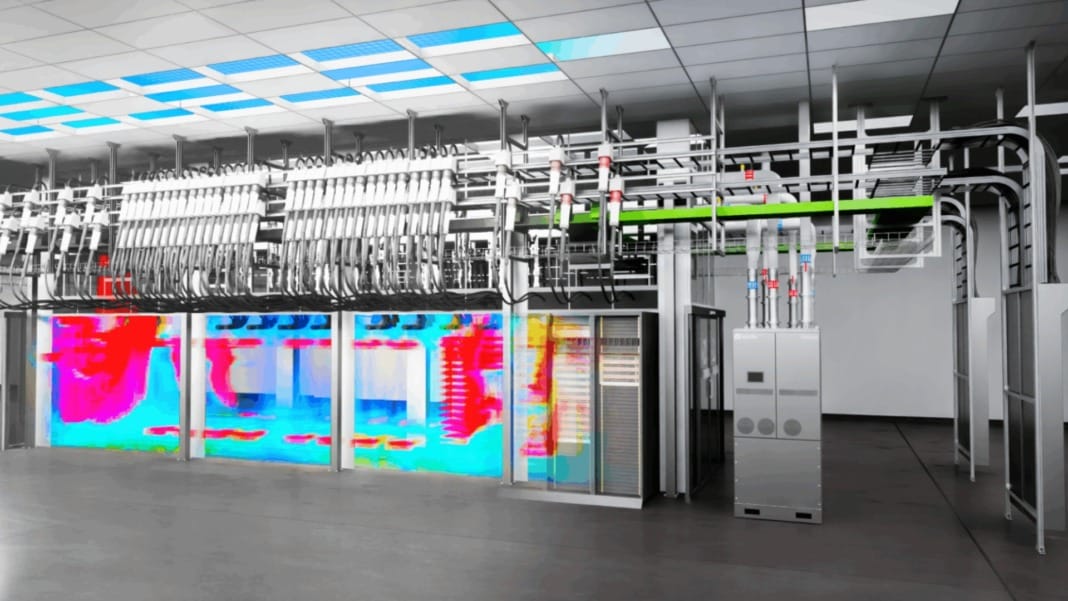NVIDIA has introduced an expanded version of its Omniverse Blueprint for AI factory digital twins, now available in preview. This update brings a host of new tools and ecosystem integrations, designed to support engineering teams in designing, simulating, and optimising data centre infrastructure for large-scale AI workloads.
With new contributions from Delta Electronics, Jacobs, and Siemens, alongside existing partners like Cadence, Schneider Electric (with ETAP), and Vertiv, the initiative further unifies the design and simulation of power, cooling, and networking systems across AI factory environments. The expanded blueprint allows teams to detect issues early and build more intelligent and resilient facilities before physical construction begins.
The enhancements are based on reference architectures for NVIDIA’s GB200 NVL72-powered AI factories. Leveraging the Universal Scene Description (OpenUSD) framework, the blueprint aggregates detailed 3D and simulation data into a single virtual model. This enables developers to accurately represent the physical components of AI factories, from infrastructure to environmental systems, in a unified design workflow.
More partners bring AI factory assets to Omniverse
The Omniverse Blueprint’s growing ecosystem includes partners that contribute 3D models and simulation-ready assets, known as SimReady, helping create realistic digital representations of AI factories. Siemens is contributing OpenUSD-based 3D models and participating in the SimReady standardisation effort, while Delta Electronics is providing models of its equipment. Jacobs is supporting workflow testing and optimisation.
They join Schneider Electric, Vertiv, and ETAP, whose SimReady assets support detailed digital modelling of power, cooling, and mechanical systems. These integrations make it possible to simulate complex infrastructure in a highly accurate virtual environment.
“As AI factories continue to scale at an unprecedented pace, the energy demands they generate are reshaping the entire digital infrastructure landscape,” said Tanuj Khandelwal, CEO of ETAP. “Using the Omniverse Blueprint and SimReady assets, customers can test and optimise energy efficiency for the complexity and intensity of their AI workloads before even breaking ground.”
Connections to Cadence’s Reality Digital Twin Platform and ETAP allow teams to simulate thermal and power demands with precision. These integrations enable early-stage design validation, ensuring that AI factories are both energy efficient and resilient against failure.
Ben Gu, corporate vice president of R&D for multiphysics system analysis at Cadence, added, “The integration of the Cadence Reality Digital Twin Platform with the NVIDIA Omniverse Blueprint transforms the entire engineering process to design AI factories more efficiently and operate them more effectively than ever before.”
SimReady standard aims to streamline digital twin development
The SimReady standard plays a central role in the blueprint expansion. Originally developed by NVIDIA to streamline its internal creation of OpenUSD assets, the standard is now publicly available and vendor-neutral. It outlines the key requirements for building simulation-ready models and workflows that are both physics-based and interoperable.
By adopting SimReady standards, developers and data centre owners can more easily build, test, and optimise digital twins of critical infrastructure. These include thermal airflow simulations, power systems, and building automation controls, supporting the development of next-generation AI operations with greater speed and accuracy.
The physics-based nature of SimReady assets also supports the development of industrial AI applications, such as agentic AI systems for managing and automating infrastructure performance. These capabilities are essential for future-ready AI factories that rely on real-time monitoring and adaptive systems.
Paving the way for smarter AI infrastructure
The enhanced Omniverse Blueprint represents a major step forward in the digital transformation of AI infrastructure. It allows engineers to plan and optimise complex environments virtually, reducing risk and improving efficiency before breaking ground on physical construction.
By uniting high-fidelity digital twin capabilities with ecosystem-wide collaboration, NVIDIA is positioning the Omniverse Blueprint as a critical tool for scaling AI infrastructure to meet global demand. With support for standardised, simulation-ready workflows, the framework offers a new approach to designing smarter, more sustainable data centres for AI.





